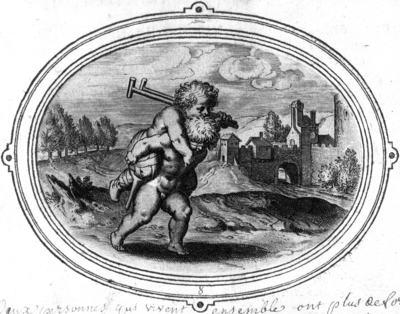Duo simul viventes ad intelligendum et agendum plus valent quam unus [8]

Translations
 |
Aristoteles, Ethica Nicomachaea 8, 1, 2 Bekker p. 1155 a 15-16.
Als twee tezamen leven kunnen ze beter plannen maken en uitvoeren dan één alleen. |
 |
Aristoteles, Ethica Nicomachaea 8, 1, 2 Bekker p. 1155 a 15-16.
Two living together have more strength to understand and act that one. [Loeb: Two are better able both to plan and to execute] |
Literature
- Praz, Seventeenth-Century Imagery
 , p. 114
, p. 114
- Sebastiàn, Lectura crítica
 , p. 18
, p. 18
Sources and parallels
- Duo simul viventes ad intelligendum & agendum plus valent quam unus [6] (in: Otto Vaenius, Emblemata aliquot selectiora amatoria (1618))
[Compare
![Compare [compare]](/static/images/compare2.gif) ]
]
- Zeste Verdeeling. [6] (in: Jan Luyken, Duytse lier (1671))
[Compare
![Compare [compare]](/static/images/compare2.gif) ]
]
- Alciato, Book of Emblems
 , embl. 161
, embl. 161
References, across this site, to this page:
- Zeste Verdeeling. [6] (in: Jan Luyken, Duytse lier (1671))
- Duo simul viventes ad intelligendum & agendum plus valent quam unus [6] (in: Otto Vaenius, Emblemata aliquot selectiora amatoria (1618))
Iconclass
The halt leading the blind: a blindfolded cupid carrying a crippled cupid on his back- brook
[25H212]

- landscape with tower or castle
[25I5]

- landscape with bridge, viaduct or aqueduct
[25I6]

- walking
[31A2711]

- blindfold
[31A3191]

- blind, blindness
[31A4111]

- the halt leading the blind
[31A41112]

- crippled
[31A415]

- castle
[41A12]

- quiver
[45C23]

- carrying a person on one's back
[46C1271]

- Co-operation, Association (+ emblematical representation of concept)
[54E1(+4)]

- (personifications and symbolic representations of) Love; 'Amore (secondo Seneca)' (Ripa) (+ emblematical representation of
concept)
[56F2(+4)]

- proverbs, sayings, etc. (with TEXT)
[86(DUO SIMUL VIVENTES AD INTELLIGENDUM ET AGENDUM PLUS VALENT QUAM UNUS)]

![[H O M E : Emblem Project Utrecht]](/static/images/rd-small.gif)


















































































































































